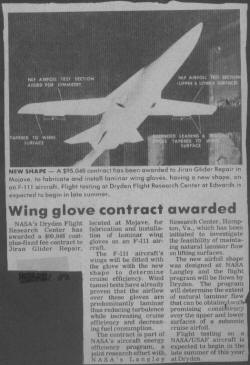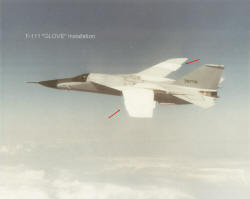

![]()
F-111
click on the "pics" to enlarge or go to their subject pages
 |

_small.jpg) |
| AWARDED (worth reading) | COMPLETED |
This project was a "first of a kind" attempt to drastically change the airfoil, on a large aircraft, to verify wind tunnel data. The object was to develop airfoils for transport category aircraft. The airfoil we were about to install on this F-111 was very "thick" and had a larger cord than the existing wing. The speeds for which it was designed were around Mach 0.8. (typical airliner speeds) the airfoil, due to its thickness, would allow for a lighter wing structure as well as provide additional volume for fuel. The hope was to have laminar airflow over a large proportion of the wing. We were to modify both wings in order to keep them somewhat symmetrical. The actual test section was on one wing only and it was the only area that also had a lower surface test section. This turned out to be the very most difficult portion of the task. considering that the contour accuracy was to be "the best that could be done" and the smoothness to be at least as good as a Sailplane wing.
|
The airfoil, making a template |
Glove installed on the underside |
Test section - upper surface |
"Tufting" to show the air flow |
Then the removal of the "stuff" |
The effort took more than a year. The results, I was told, were well worth the time and money spent. Martha Bohn-Meyer and I co-authored an award winning paper describing the methods used to accomplish the work. Subsequent airfoil testing followed similar methods, developed during this project. The F-14 Variable Sweep Transition Flight Experiment, was just one of them